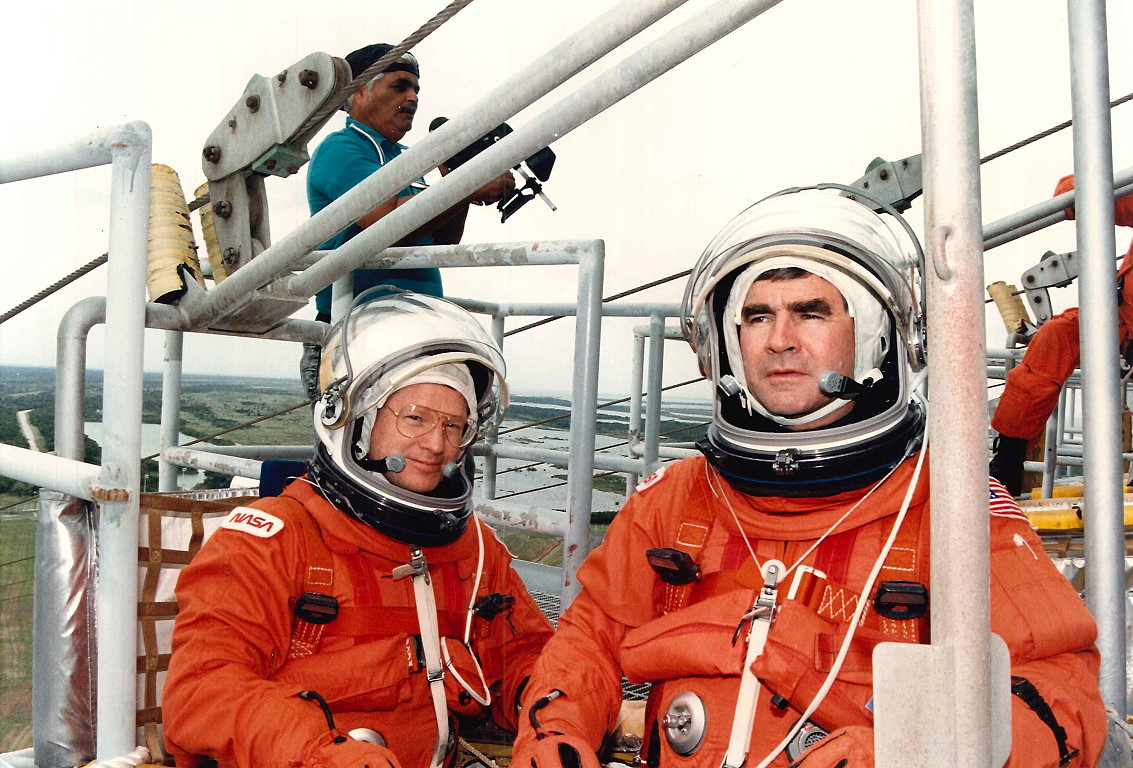
“You’ve got to believe in your dreams,” astronaut Lacy Veach once told a crowd of Hawaiian youngsters, “and you’ve got to be hard-headed enough to never let go!” Had cancer not cruelly snatched him from us, today (18 September) would have been Veach’s 70th birthday, and his legacy as a pilot, engineer, instructor, explorer, teacher, and adventurer continues through annual “Lacy Veach Days of Discovery” at his former alma mater, Punahou School in Honolulu, Hawaii, which seeks to encourage the young to participate in science-based workshops and demonstrations and inspire them to believe in their own dreams and—just as Veach himself did—to pull out every stop in order to achieve them. It also continues aboard the International Space Station (ISS), whose cupola contains Veach’s name tag and a photograph in honor of the man who worked on the early development of the multi-windowed module.
Born Charles Lacy Veach in Chicago, Ill., on 18 September 1944, he spent most of his formative years and received much of his early schooling in Hawaii. The notion of someday becoming an “astronaut” came in early in life. When he was only six years old—and still a decade before the first human being would venture into space—he took a comic book to his mother, pointed to a picture of a man standing on the Moon with what looked like a goldfish bowl on his head, and declared: “That’s what I want to be!”
Veach completed Punahou School in 1962 and entered the U.S. Air Force Academy, receiving a degree in engineering management. His military career began with receipt of his pilot’s wings from Moody Air Force Base, near Valdosta, Ga., in 1967, and he undertook fighter gunnery training at Luke Air Force Base in Glendale, Ariz. Veach spent the next 14 years as an active duty fighter pilot, flying the F-100 Super Sabre, the F-111 Aardvark, and the F-105 Thunderchief in the United States, Europe, and—significantly—Vietnam, where he performed no fewer than 275 combat missions, was shot down twice, and earned a Purple Heart. In doing so, Veach became only the second NASA astronaut (after Bob Stewart) to fly into space, having previously earned a Purple Heart. He later served as a member of the Air Force’s aerial demonstration squadron, the famed “Thunderbirds,” and although he resigned from active military duty in 1981 he continued to fly the F-16 Fighting Falcon with the Texas Air National Guard.
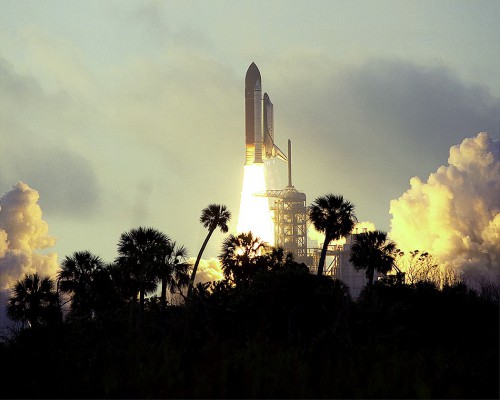
His NASA career began in January 1982 as an engineer and civilian research pilot at the Johnson Space Center (JSC) in Houston, Texas, during which time Veach instructed astronauts to fly the Shuttle Training Aircraft (STA). He was selected as a shuttle mission specialist candidate, part of the 10th group of NASA astronauts, in May 1984.
The loss of Challenger in January 1986 delayed Veach’s first mission assignment. At length, following the resumption of shuttle operations in the fall of 1988, he and veteran astronaut Guy Bluford were assigned to work with the Air Force on developing payloads for carriage aboard the reusable orbiters. The two men worked at the Air Force Space Systems Division and the Aerospace Corporation in El Segundo, Calif., and in May 1989 they and a third astronaut, Rick Hieb, were named to the crew of STS-39, an unclassified Department of Defense mission. Its principal payload consisted of the Lockheed-built Air Force Project (AFP)-675 and the Infrared Background Signature Survey (IBSS), provided by the Strategic Defense Initiative (SDI), the latter of which was to be deployed and later recovered aboard a retrievable Shuttle Pallet Satellite (SPAS).
At the time of the assignment of Bluford, Veach, and Hieb, STS-39 was scheduled to launch in July 1990, but found itself repeatedly delayed. In a sense, this proved beneficial for the three men, for their training was incredibly complex. Air Force Maj. Rob Crombie, who had been selected earlier in the 1980s as a Manned Spaceflight Engineer (MSE), worked with them to develop the flight procedures, including malfunction plans for AFP-675 and IBSS, and every few weeks in the summer of 1989 Bluford and Veach flew out to Lockheed’s Space & Missiles facility in San Jose, Calif., to work them through in a full shuttle flight deck simulator with payload controls and displays. They also worked independently on other areas, in order to ensure a firm grasp of the material.
As STS-39 slipped toward the end of 1990, there opened up a brief window of respite for the men to do other things. “Lacy had to take three to four months off,” Bluford recalled in his NASA oral history, “to go to McConnell Air Force Base in Wichita, Kan., for training in the F-16. We adjusted his training flow to take that into account and Lacy never missed a beat when he returned.”
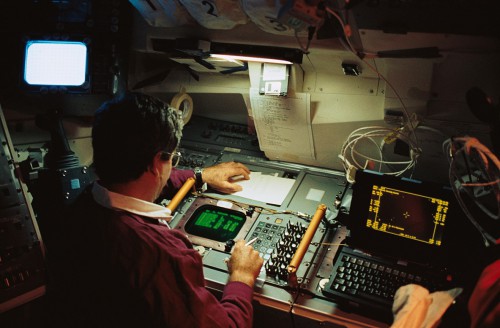
By the fall of 1989, the remainder of the STS-39 astronauts—Commander Mike Coats, Pilot Blaine Hammond, and two more mission specialists, Greg Harbaugh and Don McMonagle—had been announced and commenced integrated training as the first (and only) seven-strong Department of Defense shuttle crew. The complexity of the scientific research and rendezvous operations demanded a 24-hour, around-the-clock mission, and the crew was divided into “red” and “blue” shifts. Lacy Veach was on the red shift, with key responsibility for the systems of the AFP-675 and IBSS payloads.
“We had to do rendezvous, multiple translation maneuvers, extended station-keeping and deployment and retrieval of the SPAS,” recalled Bluford. “This involved precision orbiter maneuvering, IBSS-SPAS commanding, IBSS observation sequences and multi-body management in a very intensive timeline. A lot of co-ordination was required on the flight deck, synchronizing orbiter and SPAS maneuvers and documenting key events. There was approximately 36 hours planned for rendezvous and proximity operations.”
STS-39 marked the first space mission of not only Lacy Veach, but also most of the rest of the crew; in fact, only Mike Coats and Guy Bluford had flown before. Discovery lifted off at 7:33 a.m. EDT on 28 April 1991, and shortly after achieving orbit the red team of Coats, Hammond, Veach, and Hieb took charge of activities to power up and check out the expansive array of payloads. This proved somewhat problematic, when two AFP-675 tape recorders stopped working after only four hours of operation. This demanded a difficult bypass repair, in which the astronauts rerouted wires and attached a splice to the shuttle’s Ku-band antenna to permit direct downlink to ground stations.
Yet STS-39 turned out to be remarkable success, ending on 6 May, after eight days. Later that summer, Veach was reassigned to his second shuttle mission, STS-52, which took place in October 1992. Key objectives for this 10-day flight were the deployment of Italy’s second Laser Geodynamics Satellite (LAGEOS-2) and multiple research and technology payloads, including a range of Canadian experiments. Veach’s Hawaiian upbringing and his keen fascination for the ancient Polynesian canoes and Pacific voyages prompted him to carry a stone adze into orbit with him and display it prominently aboard the shuttle.
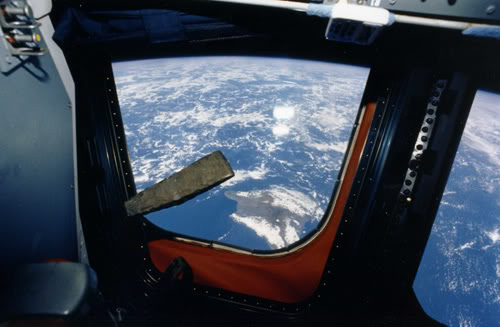
Veach had received the adze from his grandfather. It originated in the Keanakako’i quarry, located about 12,500 feet (3,800 meters) high on the slopes of Mauna Kea, and during STS-52 Veach photographed it floating in Columbia’s windows, with its Hawaiian place of origin visible far below. Several years later, Veach told an interviewer that “you can never believe the beauty of Island Earth until you see it in its entirety from space.”
During STS-52, he worked with Canadian astronaut Steve MacLean to evaluate a prototype Space Vision System (SVS) for Space Station Freedom, which was capable of providing position, orientation, and motion data. Veach used the shuttle’s Remote Manipulator System (RMS) mechanical arm to deploy a domino-like device, called the Canadian Target Assembly (CTA), which MacLean used as a monitoring target. “This,” commented a clearly impressed Lacy Veach, “could be as revolutionary as instrument flying was to aviation.”
Aviation, indeed, was in Veach’s blood. And flying in space was the ultimate form of aviation. At one of his many presentations to Hawaiian schools, Veach was surprised when one of the children walked up to him and poked him. “I’m just checking,” the child told his friend, “to see if he’s real!” By the end of STS-52, he had accrued a total of 18 days in space and subsequently led the Astronaut Office’s development and operations of robotics for the future International Space Station (ISS). One of his key recommendations was for a multi-windowed cupola aboard the station to support rendezvous and docking operations, to monitor robotic operations, and to support spacewalkers, as well as offering a spectacular viewing location of the Home Planet.
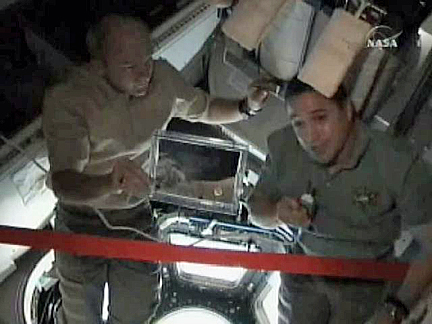
The early development of the cupola was one of the last projects that Veach worked on before his untimely death from skin cancer, aged just 51, on 3 October 1995. Fifteen years later, his contributions and visionary foresight paid dividends. When the Tranquility node and cupola were installed onto the ISS by the STS-130 shuttle crew in February 2010, the official opening of the new module was dedicated to Veach’s memory. Just prior to cutting the ceremonial ribbon, STS-130 Commander George Zamka and Expedition 22 Commander Jeff Williams paused to honor him.
“We also want to take this moment to remember a friend and co-worker and fellow astronaut, Lacy Veach,” Williams began, “who was really dedicated to the early development of the cupola and its vision of the International Space Station.” Without further ado, Williams pulled out Veach’s flight badge and displayed it to the camera, whilst Zamka produced a photograph of the late astronaut, as well as an Apollo 11 Moon rock, for permanent display inside the cupola.
And that—a panoramic and inspirational view of the Home Planet—must surely be one of Veach’s legacies, not only to the ISS program, but to history. On one of his missions, he had been awakened to float up to a window to watch the Hawaiian islands drift serenely below the shuttle’s ground track and had been profoundly moved. “He could see his whole spirit and soul here,” recalled Veach’s lifelong friend, the Hawaiian navigator Nainoa Thompson. “He saw the entire planet in one vision.”
Want to keep up-to-date with all things space? Be sure to “Like” AmericaSpace on Facebook and follow us on Twitter: @AmericaSpace




Thank you for such a wonderful tribute!
Such a wonderful remembrance of all the amazing accomplishments of my uncle. He was a truly fascinating man.
What a fabulous article honoring a Lacy. Although I know Lacy touched many people, I remember my husband, my friend, a loving father, and someone who made us laugh. A day does not go by that I don’t think about him and miss him.